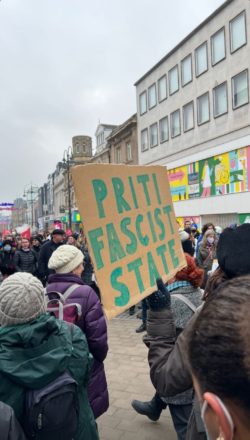“Kill the Bill!”: The Last Protest of its Kind?

Leeds "Kill the Bill" Protest. January 2022. Photograph: Tilen Kolar
By Marria Noor Sajid
For the past few months, many of us will have seen large scale protests in cities across the UK. Aptly named “Kill the Bill!”, this chant has echoed throughout the country, with protestors and activists alike protesting against Government plans to give police new powers to clamp down on protestors through a new bill.
What is the Police, Crime, Sentencing and Courts Bill and what does it mean?
The bill in question is known as the Police, Crime, Sentencing and Courts Bill, which is an Act proposed in March 2021, sponsored by the Home Office and Priti Patel. Upon analysis of Part 3 and 4 of the bill, “Public order and unauthorised encampments” (available as part of the Parliamentary Library briefing), some of the most notable proposals made by the Bill include an amendment to police powers in the Public Order Act 1986, for the purpose of allowing police to impose conditions on protests that are noisy enough to cause “intimidation or harassment” or “serious unease, alarm or distress” to bystanders.
Widening the range of conditions that that the police can impose on static protests, such as start and finish times, as well as maximum noise levels is most troubling, especially when considering the Government’s reasoning behind the measures. The PCSC Bill protest powers factsheet and policy paper states that the measures are needed because some protestors cause a ‘disproportionate impact on the hardworking majority seeking to go about their everyday lives’ and protests have ‘not only been highly disruptive and sometimes incredibly dangerous, they have also been a drain on public funds’.
One should question why the ’disruptive’ nature of protests warrants such restrictions. Are such measures really necessary? Surely the sole purpose of protest is to express objection and disapproval? One way to achieve this is through disruption. Protest and the resultant disruption allows society to reflect and consider issues at hand and messages being communicated by protests and protestors alike. Disruption conveys the imperative nature of an issue, allowing issues at hand to gain traction and attention. Therefore, it can be said that imposing restrictions on protests due to their ‘disruptive’ nature defeats the purpose of protests, thereby severely limiting and infringing on a right that is fundamental to democracy and liberty.
How are human rights affected by the Bill?
The Bill has been condemned by human rights activists as an attack on the right to protest, with many campaigners arguing that the Bill violates Human Rights. This is highlighted by Article 11 of the European Convention of Human Rights, which the UK was the first nation to ratify in 1951. Under this article, everyone has the right to freedom of assembly, which includes the right to protest. Moreover, it should be noted that the Convention also explicitly prohibits forces such as the police, the armed forces, or the administration of the state from imposing restrictions on this right to assembly.
By limiting and restricting the right to protest, the Government is not only infringing upon its citizens’ human rights, but also possibly violating the European Convention of Human Rights. However, when considering this possible violation of the European Convention of Human Rights, the PCSC Bill protest powers factsheet and policy paper states that the ‘ECHR is explicit in stating that public authorities may temporarily restrict these rights in extreme circumstances if they can show that their action is lawful, necessary and proportionate in preventing disorder or crime [among other reasons]’. When analysing this statement, many questions regarding the future of protest are raised. Will there be further restrictions? Who exactly will define the framework through which public authorities’ actions can be considered lawful, necessary and proportionate in preventing disorder or crime?
What stage is the Bill at and what changes have occurred?
The Bill is in its final stages as it has currently passed its third reading in both the House of Commons and House of Lords with amendments made by the Lords currently being considered by the Commons. During the latest reading, the Government faced a series of defeats as Peers in the House of Lords voted against the Government’s plans to create a new offences and provisions. These included "locking on" (a tactic used by protesters to make it difficult to remove them), giving police power to stop and search anyone at a protest "without suspicion", and make it an offence for a person to interfere with the use or operation of key national infrastructure, including airports, the road network, railways and newspaper printers. Most importantly, Peers voted for new amendments to the Bill, which would scrap the power to impose conditions on protest marches judged to be too noisy.
What Next?
This move by the House of Lords is very encouraging, particularly because the amendments voted down by the Lords cannot be reinstated. However, as noted by Martha Spurrier, the Director of Liberty, an advocacy group and political pressure group which promotes human rights, despite the House of Lords’ vote against outlawing traditional protest tactics, Liberty expects to see similar measures return in a new Bill.
This is further evidenced by an Interview on BBC Radio 4’s Today Programme, where the Secretary of State for Justice Dominic Raab responded affirmatively to the question of whether measures against noisy protests would be reintroduced.
It therefore seems that despite the House of Lords’ amendments, the Government’s moves to restrict protests is not yet out of the question. Undoubtedly, this raises questions about any future bills, the potential for further restrictions and what this means for citizens.
Marria Noor Sajid – Penultimate Year BA Arabic and International Relations
